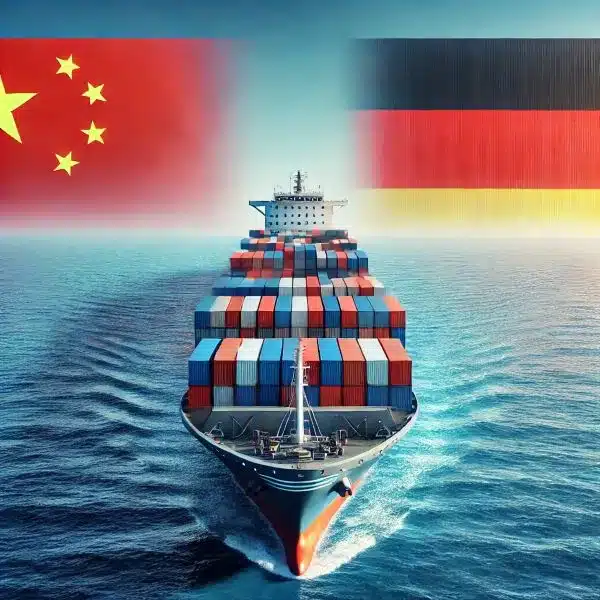- By TOP CHINA FREIGHT
- September 22, 2025
- Sea Freight, Shipping
Table of Contents
Sea freight China to Germany is one of the most critical logistics routes for global trade, connecting Asia’s largest manufacturing hub with Europe’s biggest economy. While air freight offers speed and rail freight provides balance, shipping by sea remains the most cost-effective solution for large cargo volumes. However, businesses often face challenges such as long transit times, customs clearance, and freight rate fluctuations.

Why Choose Sea Freight from China to Germany?
Sea freight remains the backbone of international trade, especially when moving large volumes. For importers shipping containers of electronics, textiles, furniture, or machinery, sea transport is often the most practical solution.
- Cost-effectiveness: Ocean freight is cheaper compared to air or rail when shipping bulk cargo.
- Capacity: Vessels can handle everything from small LCL shipments to full 40ft containers.
- Flexibility: Multiple shipping lines and schedules offer a wide range of options.
- Sustainability: Lower carbon emissions per ton compared to air freight.
Moreover, with Germany being Europe’s logistics hub, ports such as Hamburg and Bremerhaven provide excellent connections to inland destinations.
How Long Does Sea Freight from China to Germany Take?
Transit time is one of the main concerns for importers. On average, sea freight from China to Germany takes 30–40 days, depending on the route, origin port, and type of service.
| Origin Port in China | Destination Port in Germany | Transit Time (Days) |
|---|---|---|
| Shanghai | Hamburg | 30–32 |
| Shenzhen | Hamburg | 33–35 |
| Ningbo | Bremerhaven | 31–34 |
| Qingdao | Hamburg | 35–38 |
| Tianjin | Bremerhaven | 36–40 |
While air freight may take just 5–7 days, the cost difference makes sea freight the preferred choice for businesses moving high-volume goods.
What Are the Costs of Sea Freight China to Germany?

Freight costs vary based on container size, seasonality, and market demand. On average:
Several factors affect pricing:
- Fuel surcharges (BAF) and currency adjustments.
- Peak season surcharges, especially before Chinese New Year.
- Port handling fees in China and Germany.
- Container availability, which may push up rates during shortages.
Which Ports in China and Germany Handle Sea Freight?
Efficient port connections are crucial for timely shipments.
Major Chinese Ports:
- Shanghai – Largest port in the world, handling diverse cargo.
- Shenzhen (Yantian, Shekou) – Strong in electronics and consumer goods.
- Ningbo-Zhoushan – Specializes in heavy machinery and textiles.
- Qingdao – Strategic for northern China exports.
- Tianjin (Xingang) – Serves Beijing and northern industrial areas.
Major German Ports:
- Hamburg – Germany’s largest port, strong connections to Central Europe.
- Bremerhaven – Handles automotive and containerized goods.
- Wilhelmshaven (JadeWeserPort) – Deep-water port suitable for mega-vessels.
What Are the Shipping Methods for Sea Freight?

shipping.
| Method | Best For | Pros | Cons |
|---|---|---|---|
| FCL (20ft/40ft) | Large shipments | Lower cost per unit, secure, faster | Higher upfront cost if underutilized |
| LCL (consolidation) | Small shipments | Cost-sharing, flexible | Longer handling time, higher risk of delays |
Additionally, importers can consider breakbulk cargo for oversized items or RORO (Roll-on/Roll-off) for vehicles.
Customs Clearance for Sea Freight China to Germany

Successful customs clearance is key to avoiding costly delays. Importers must prepare the following documents:
| Document | Purpose |
|---|---|
| Commercial Invoice | Details value and nature of goods |
| Packing List | Itemized cargo breakdown |
| Bill of Lading | Contract of carriage issued by carrier |
| Import License (if applicable) | Required for restricted goods |
| Certificates of Origin | Proof of product origin |
| Customs Declaration | Filed with German customs authorities |
How to Calculate Duties and Taxes?
When shipping goods, businesses must account for customs duties, VAT, and additional charges.
- Customs Duty: Based on HS code classification and product type.
- VAT (Value Added Tax):Standard rate of 19% applied on CIF value + duty.
- Additional Costs: Anti-dumping duties, excise tax (for certain goods).
Example:
If the CIF value of your shipment is $20,000 and the customs duty rate is 5%, then:
- Duty = $1,000
- Taxable amount = $21,000
- VAT (19%) = $3,990
Total payable = $4,990
Case Study: Importing Furniture from China to Germany

A German furniture retailer shipped a 40ft FCL from Ningbo to Hamburg.
- Transit time: 33 days port-to-port.
- Freight cost: $2,700 for the container.
- Customs clearance & port fees: $950.
- Total landed cost (including VAT): $4,600.
By planning shipments three months in advance and consolidating orders, the retailer reduced overall costs by 15% compared to air freight.
Pros and Cons of Sea Freight vs Other Modes
| Mode | Transit Time | Cost | Best For |
|---|---|---|---|
| Air Freight | 5–7 days | Very high | Urgent, small shipments |
| Rail Freight | 16–22 days | Moderate | Medium cargo, faster than sea |
| Sea Freight | 30–40 days | Lowest | Bulk goods, cost-sensitive cargo |
Therefore, businesses must balance time, cost, and reliability when choosing transport modes.
How to Reduce Sea Freight Costs from China to Germany?
- Book early during peak seasons.
- Use FCL if cargo volume is sufficient.
- Consolidate shipments for LCL to reduce per-unit cost.
- Negotiate with freight forwarders for better rates.
- Choose alternative ports to avoid congestion.
Additionally, using a reliable freight forwarder ensures smooth handling of customs and cargo tracking.
Conclusion
Sea freight China to Germany remains the most practical and affordable solution for businesses importing goods in bulk. Although transit times are longer compared to rail or air, the cost savings and capacity make it the backbone of supply chains between Asia and Europe. By understanding costs, transit times, port options, and customs procedures, importers can plan effectively and avoid unexpected delays. Ultimately, choosing the right freight forwarder is the key to reliable sea freight transport from China to Germany.
Need a Shipping Quote?
If you want expert guidance and peace of mind, our team is ready to assist.
TJ China Freight offers tailored solutions to help businesses of all sizes ship more reliably from China.

FAQ
Q1:How much does sea freight from China to Germany cost?
Costs vary by container size and season, but typically range between $1,200 for a 20ft and $3,200 for a 40ft container.
Q2:Can I ship small cargo by sea from China to Germany?
Yes, LCL (Less than Container Load) allows you to ship smaller volumes without booking a full container.
Q3:What documents are needed for customs clearance?
You need a commercial invoice, packing list, bill of lading, and certificates of origin. Additional documents may apply for restricted goods.
Q4:How do I calculate customs duty and VAT?
Duties depend on HS code classification, while Germany applies a 19% VAT on the CIF value plus duty.
Q5:How long does sea freight from China to Germany take?
Transit usually takes 30–40 days depending on the port of origin, destination, and shipping line.
